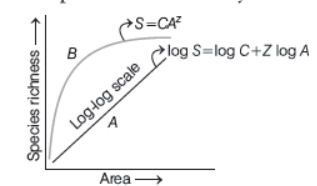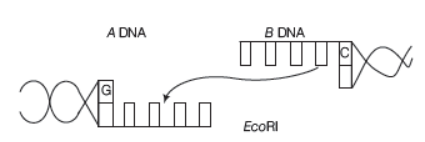See below CBSE Class 12 Biology Term 2 Sample Paper Set B with solutions. We have provided CBSE Sample Papers for Class 12 Biology as per the latest paper pattern issued by CBSE for the current academic year. All sample papers provided by our Class 12 Biology teachers are with answers. You can see the sample paper given below and use them for more practice for Class 12 Biology examination.
CBSE Sample Paper for Class 12 Biology Term 2 Set B
1. Direction Read the following passage and answer the questions that follows.
Biodiversity is not uniform throughout the world. It varies with the changes in latitude and altitude. For many groups of animals and plants, there are specific patterns in diversity based on the favourable environmental conditions as plants and animals are more diverse in areas, which are best suited for their survival.
A German naturalist and geographer during his pioneering and extensive explorations in the wilderness of South American jungles, observed the pattern of biodiversity and described it through the following graph.

(i) Name the naturalist who studied the kind of relationship shown in the graph. B
(a) Robert May
(b) Alexander von Humboldt
(c) David Tilman
(d) Paul Ehrlich
(ii) What does ‘Z’ stands for in the given equation of the graph? D
(a) Species richness
(b) Intercept
(c) Area explored
(d) Regression coefficient
(iii) The value of Z is D
(a) constant
(b) zero
(c) one
(d) fluctuating
(iv) The slope of the line ‘B’ become steeper for B
(a) forest
(b) continents
(c) small areas
(d) pond
(v) The given graph shows C
(a) the species richness decreased with increase in explored area
(b) the species richness remain constant regardless of the region
(c) the species richness increased with increasing explored area, but only upto a limit
(d) there is no relation between species richness, taxonomic group and region to be explored
2. (i) How do organic farmers control pests? Give two examples.
(ii) State the difference in their approach from that of conventional pest control methods.
Answer : (a) Natural predation / biological control
Examples – lady bird used to kill aphids / dragon flies used to kill mosquitoes//Bacillus thuringiensis used to kill cotton bollworm / caterpillar / butterfly caterpillar.
Or
What is IPM? Give an example of bioinsecticides and bioherbicides and how do they help in pest control?
Answer : Integrated Pest Management (IPM) involves several pest-control methods which promote biological control methods instead of the use of chemical pesticides, thus, saving the environment from agrochemical problems. It involves following few control methods.
(i) Soil conditioning, crop rotation, proper sanitation practices.
(ii) Eliminating pest by starvation.
(iii) Mixing crop with specific weed on which insect may feed instead of crop.
Bioinsecticides are living organisms usually insects or microorganism which help to control other insect-pests e.g., lady bugs control aphids in crops. Bioherbicides are insects or micro-organism which are used to control weeds. e.g., the fungus Phytophthora palmivora checks the growth of milkweed vines in citrus orchards. These organisms feed selectivity or produce diseases in weed and thus eliminate them. checks the growth of milkweed vines in citrus orchards. These organisms feed selectivity or produce diseases in weed and thus eliminate them.
3. (i) It is generally observed that the children who had suffered from chickenpox in their childhood may not contract the same disease in their adulthood. Explain giving reasons the basis of such an immunity in an individual. Name this kind of immunity.
(ii)What are interferons? Mention their role.
Answer : (a) The type of immunity is active immunity.
When exposed to the pathogen for the first time, the primary immune response casues the release of the relevant antibodies against the pathogen. Some memory cells are created. These help to prevent the second recurrence of the disease in adulthood by eliciting a highly intensified secondary response.
(b) Interferon : These are proteins made and released by viral infected cells which protect other non-infected cells from viral infection.
Role of interferons – They help in preventing viral infection of the adjoining cells. They are also given to cancer patients to destroy tumour as it activates the immune system.
4. Medically it is advised to all young mothers that breast-feeding is the best for their newborn babies. Do you agree? Give reasons in support of your answer.
Answer : Breastfeeding is important for newborn babies because breast milk has valuable immunoglobulin which improves the immune power of the newborn. It has a good amount of Ig A initially along with water, fat, carbohydrates, protein, vitamins and minerals, amino acids, enzymes, and white cells.
5. What is gene therapy? Which disease can be cure by gene therapy?
Answer : Gene therapy is a treatment technique that uses genes to treat or prevent disease. It presents the possibility to alter the genes inside, or outside, a patient’s cells, in an effort to treat and ultimately eliminate the disease instead of treating symptoms and diseases as done with traditional drugs and surgery.
Or
The following illustrates the linking of DNA fragments

(i)Write the name of A and B.
(ii) Complete the palindrome, which is recognised by EcoRI.
(iii)Write the name of the enzyme that can link the two DNA fragments.
Answer :
(i) a–Vector DNA
b–Foreign DNA
(ii) 5′ — GAATTC — 3′
3′ — CTTAAG — 5′
(iii) DNA ligase
6. How has the study of biotechnology helped in developing pest resistant cotton crop? Explain.
Answer : Some strains of Bacillus thuringiensis produce proteins that kilI insects (pests), these crystals contain a toxic insecticidal protein, once the insect ingests this (inactive) toxin it is converted into an active form, due to alkaline pH of the gut, activated toxin binds to surface of midgut epithelial cells and creates pores, causing swelling and lysis leading to death of pest.
Or
(i) Mention the importance of gel-electrophoresis in biotechnology.
(ii) Explain the process of this technique.
Answer : a) The cutting of DNA by restriction endonucleases results in the fragments of DNA. These fragments can be separated by a technique known as gel electrophoresis. And we can extract our desired fragment based on its molecular size.
b) 1. DNA fragments are negatively-charged molecules they can be separated by forcing them to move towards the anode under an electric field through a medium/matrix. (agarose).
2. The DNA fragments separate (resolve) according to their size through the sieving effect provided by the agarose gel. Hence, the smaller the fragment size, the farther it moves.
3. The separated DNA fragments can be visualized only after staining the DNA with a compound known as ethidium bromide followed by exposure to UV radiation
4. Bright orange coloured bands of DNA in an ethidium bromide-stained gel exposed to UV light are seen.
5. The separated bands of DNA are cut out from the agarose gel and extracted from the gel piece. This step is known as elution.
7. Mention any four methods involved in the treatment of cancer.
Answer :
(i) Surgery: Cancers in organs like the breast, prostate and testicles can be cured by the removal of those parts through surgery. This is the oldest known treatment option, which is effective if metastasis has not taken place and if cancer is localised to a small portion of the body. It cannot be employed for leukaemias.
(ii) Radiation therapy: This is the most commonly used therapeutic option against cancer. During this therapy, high-energy x-rays created in special machines and high-energy gamma-rays emitted from radium are focused specifically on the cancerous cells. These high energy radiations damage the molecules making up the cancerous cells. This treatment can independently shrink the tumour size or obliterate the cancer cells. This treatment option is effective in the case of skin, lips, mouth and cervical cancers. This therapy is administrated in almost 80% of cancers. The side effect of this treatment is that it can damage the normal tissues also that lie adjacent to the cancerous tissues.
(iii) Chemotherapy: This therapy involves the use of chemicals which can inhibit the active cell division process so that the process of apoptosis(cell death) gets stimulated within the cancer cells. This treatment is generally chosen as an option in case of cancers which have spread to different parts of the body as medicines can travel to different part of the body. Medicines of the drugs used during chemotherapy are mercaptopurine, 6-aminopterin, etc. The majority of the drugs used during chemotherapy are associated with severe side effects like anaemia, hair loss, etc.
(iv) Immunotherapy: This novel therapeutic option aims to boost u the immune system so that it can attack the tumours. For example, in Radioimmunotherapy, radioisotope linked monoclonal antibodies are used for the treatment of cancer. A significant success had been achieved in the treatment of breast cancer through immunotherapy.
Or
What do understand by recombinant DNA vaccines? Give two examples of such vaccines. Discuss their advantages.
Answer : A recombinant vaccine is a vaccine produced through recombinant DNA technology. This involves inserting the DNA encoding an antigen that stimulates an immune response into bacterial or mammalian cells. Recombinant DNA technology has allowed the production of antigenic polypeptides of pathogen in bacteria or yeast. Vaccines produced using jthis approach allow large scale production and hence greater availability for immunisation, e.g., hepatitis B vaccine (Recombivax HB) produced from yeast. As of June 2015 one human DNA vaccine had been approved for human use, the single-dose Japanese encephalitis vaccine called IMOJEV, released in 2010 in Australia.
Advantages of recombinant DNA vaccines:
1. No risk for infection
2. Ease of development and production
3. Stability for storage and shipping
4. Cost-effectiveness
5. Expression and purification of recombinant proteins
6. Long-term persistence of immunogen
7. In vivo expression ensures protein more closely resembles normal eukaryotic structure, with accompanying post-translational modifications.
8. How can we as a citizen of our country, prevent the loss of biodiversity?
Answer : Biodiversity is the occurrence of different type of species, habitat, ecosystem, gene, genepool in a particular place and various parts of earth.
As an individual, biodiversity can be conserved with conservation strategies and management of both biotic and abiotic resources. ltBrgt Some of the conservation strategies are as follows
(i) Protection of useful animals and plants in their natural habitat or in situ conservation.
(ii) Preservation of critical habitats like feeding and breeding areas and resting area of endangered species to promote their growth and multiplication. ltBrgt (iii) Hunting should be banned or regulated.
(iv) Habitat of migratory animals should be protected by bilateral or multilateral agreements.
(v) People should be made aware of the importance of biodiversity and its conservation.
(vi) Over exploitation of natural resources must be avoided.
(vii) Biodiversity plays an important role in maintaining and sustaining supply of goods and services.
(viii) Conservation of biodiversity ensures well being of all the living creatures and their future generations.
Or
Of the four major causes for the loss of biodiversity which according to you is the major cause for the loss of biodiversity? Give reasons in support.
Answer : habitat lose and fragmentation is the major cause for the loss of biodiversity. Loss of habitat is mainly brought about by humans; through deforestation and pollution. More than 50% of the Amazon rainforest has been cleared by humans. Since Amazon rainforest is richest in biodiversity; reduce forest cover in this region has led to a great loss of biodiversity. This speaks about the huge impact which habitat loss and fragmentation can have on biodiversity.

